Exploring the relationship between ambient sulfur dioxide and semen quality parameters: A systematic review and meta-analysis
Seyed Sobhan Bahreiny ,Mojtaba Aghaei ,Mohammad Reza Dabbagh ,Hamid Ghorbani ,Moslem Javidan ,Reza Mohammadpour Fard,
1Student Research Committee,Ahvaz Jundishapur University of Medical Sciences,Ahvaz,Iran
2Medical Basic Sciences Research Institute,Physiology Research Center,Department of Physiology,School of Medicine,Ahvaz Jundishapur University of Medical Sciences,Ahvaz,Iran
3Department of Biology,Faculty of Science,Shahid Chamran University of Ahvaz,Ahvaz,Iran
4Department of Immunology,Faculty of Medicine,Ahvaz Jundishapur University of Medical Sciences,Ahvaz,Iran
ABSTRACT Objective: To investigate the relationship between ambient sulfur dioxide (SO2) exposure and semen quality parameters.Methods:A systematic literature search was conducted to identify relevant studies investigating the association between SO2 exposure and semen quality parameters.This search encompassed the timeframe from January 2000 to May 2023 and included electronic databases such as Web of Science,Google Scholar,PubMed,Cochrane,and Scopus.Pooled effect estimates with 95%confidence intervals (CI) were calculated using percent changes(PC).The meta-analysis included seven studies with 6 711 participants and 15 087 semen samples.Results:The results revealed a significant negative association between ambient SO2 exposure and certain semen quality parameters.In particular,SO2 exposure was associated with a significant decrease in progressive motility (PC=0.032;95% CI:-0.063 to -0.001;P=0.044) and sperm concentration (PC=-0.020;95% CI: -0.036 to -0.005;P=0.012).However,no statistically significant associations were observed for total sperm count (PC=-0.038;95% CI: -0.079 to 0.003;P=0.070),seminal fluid volume (PC=-0.009;95% CI: -0.048 to -0.030;P=0.662) and sperm motility(PC=-0.17;95% CI: -0.363 to 0.022;P=0.830).In addition,the results of the subgroup analysis revealed specific variables that were associated with the decrease in relevant sperm parameters.Conclusions: This systematic review and meta-analysis provides compelling evidence supporting a consistent negative association between exposure to ambient SO2 and semen quality parameters.
KEYWORDS: Semen quality;Sulfur dioxide;Ambient air pollution;Meta-analysis
1.Introduction
In our modern era,environmental pollutants pose a growing threat to human health[1].Among these pollutants,sulfur dioxide (SO2)stands out as a concerning and pervasive compound[2,3].SO2is released into the atmosphere by industrial processes and fossil fuel combustion and has long been considered a significant contributor to air pollution and respiratory illness[4,5].However,recent findings suggest that the effects of SO2extend far beyond the respiratory system,potentially affecting male reproductive health.
This influence is observed through its correlation with multiple semen quality parameters such as sperm concentration,motility,morphology,and DNA integrity[6].It is crucial to comprehend the correlation between environmental SO2pollution and semen quality parameters to understand how environmental pollution affects human reproductive health[7].By pooling data from multiple studies,we aim to discover potential associations and shed light on the complex interplay between environmental pollutants and male reproductive function[8].The motivation behind this study is twofold.First,with increasing environmental SO2pollution from industry and urbanization,public health and reproductive medicine must investigate the effects on semen quality parameters[9].Second,deciphering the relationship between SO2exposure and semen quality parameters can provide valuable insights into the underlying mechanisms by which environmental pollutants affect male fertility,paving the way for targeted interventions and prevention strategies.This meta-analysis aims to enhance the current comprehension of the correlation between exposure to environmental SO2and parameters related to sperm quality.The results not only augment the growing body of knowledge concerning the effects of environmental pollutants on male reproductive health but also may serve as the basis for future strategies and interventions to protect fertility in an increasingly polluted world.
2.Materials and methods
2.1.Protocol and registration
In order to ensure transparency and adhere to strict standards,this systematic review and meta-analysis study followed the Preferred Reporting Items for Systematic Reviews and Meta-Analyzes (PRISMA) guide.In addition,the study was registered in PROSPERO,a widely recognized database for registering systematic reviews[10] (CRD42023443428).
2.2.Eligibility criteria
The selection criteria for the studies included in this systematic review and meta-analysis were as follows: observational studies that investigated the association between exposure to ambient SO2and semen quality parameters,studies published between January 2000 and May 2023,and studies that provided data on semen quality parameters,including sperm concentration,motility,morphology,DNA integrity,and other relevant outcomes.The exclusion criteria comprised several elements,including studies that featured inappropriate comparators,inadequate study designs,or missing controls.Additionally,reviews,letters,editorials,animal studies,intervention studies,and conference proceedings were excluded.Finally,studies without extractable data were also not considered.The inclusion of these criteria was to ensure that the selected studies were of high quality and appropriate for the intended analysis.
2.3.Literature search
A comprehensive literature search was conducted in several electronic databases,including PubMed,Web of Science,Scopus,Cochrane,EMBASE,and Google Scholar.The search covered the period from January 2000 to May 2023.The search strategy used relevant keywords such as "ambient sulfur dioxide"," SO2"," SO2exposure","semen quality","semen parameters","semen","spermatozoa","spermatogenesis","environmental pollution","air pollution","reproductive health","male fertility" and related terms.The search strategy used relevant Boolean operators "AND" and"OR" to effectively combine keywords.
2.4.Study selection
Two authors SB &MJ conducted the initial search and evaluated the eligibility of studies based on predefined criteria.Any discrepancies were resolved by a third reviewer through consensus.The study selection process strictly adhered to the predefined inclusion and exclusion criteria.
2.5.Data extraction
A standardized data extraction form was developed to extract relevant information from the selected studies.This form was designed to adhere to the specific requirements of this metaanalysis,and a standardized checklist was explicitly created for this purpose[11,12].The checklist captured essential information,including study details (first author,publication year,region),study design,participant characteristics (age,sample size),exposure assessment methods,measured semen quality parameters,and relevant statistical outcomes.
2.6.Quality assessment
The methodological quality and potential bias of the studies included in the analysis were assessed using the Newcastle-Ottawa scale,developed specifically for evaluating nonrandomized studies in meta-analyses.The Newcastle-Ottawa scale consists of three domains: selection of participants,comparability between groups,and assessment of outcomes or exposure.Based on the assigned scores,studies were classified as either low quality (score ≤4) or high quality (score≥5),which allowed for a comprehensive assessment of their reliability and potential bias[13,14].
2.7.Statistical analysis
All statistical analyses were performed using Comprehensive Meta-Analysis (CMA) v3.7z software and IBM SPSS Statistics v26 software.All data collected from the included studies were analyzed using meta-analysis techniques.To evaluate the association between SO2exposure and semen quality parameters,the pooled percent changes (PC) ([elogscaleβ-1]×100) were used along with the corresponding 95% confidence intervals (CI)[15,16].This allowed quantification of the association per 10 μg/m3increase in SO2exposure.Statistical methods such as theI2statistic and Cochran's Q test were used to assess heterogeneity between studies.Heterogeneity was classified as low,moderate,or considerable withI2values of less than 30%,between 30% to 50%,and greater than 50%,respectively.In instances with substantial heterogeneity among studies,a randomeffects model is employed.Conversely,when there is no significant heterogeneity,a fixed-effects model is applied for the meta-analysis.However,if heterogeneity was detected,we implemented a randomeffects model.Subgroup and sensitivity analyses were performed to investigate possible sources of heterogeneity and ensure the reliability of results[17,18].Publication bias was assessed using funnel plots and statistical tests such as Egger[8].
3.Results
3.1.Characteristics of the included studies
The initial database search generated 823 articles,with 49 duplicates eliminated.After the evaluation of titles and abstracts,683 articles were excluded.For the remaining 91 articles,a thorough full-text review was performed,resulting in the exclusion of 40 studies for various reasons.Ultimately,seven studies with a total of 6 711 participants met the selection criteria. The process of screening literature is depicted in Figure 1,while the records[8,19-24]extracted from the search are illustrated in Table 1.
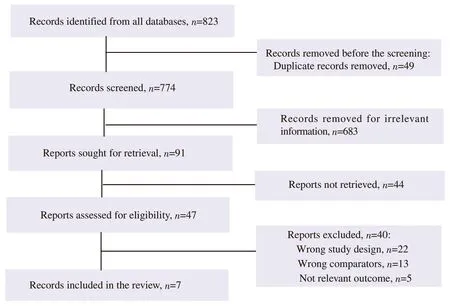
Figure 1. Flowchart of study selection.
3.2.Association and comparison details
The analysis concentrated on seven specific studies involving a total of 6 711 participants and 15 087 semen samples.The primary objective was to investigate the association between ambient SO2exposure and semen quality parameters.Subgroup analyses were conducted to explore potential sources of heterogeneity,including factors such as study design,semen analysis method,and body mass index (BMI).
To assess the methodological quality and potential bias inherent in the analyzed studies,the Newcastle-Ottawa scale was employed.The grading system outlined in Table 2 concentrates on three principal domains: participant selection,group comparisons,and the evaluation of results or exposure.The assigned scores for the quality assessment of each article ranged from 4 to 8 (Table 2).
This comprehensive approach deepened our comprehension of the association between SO2exposure and semen quality while shedding light on potential contributors to heterogeneity.
3.3.Relationship between semen quality outcomes and ambient particulate matters
3.3.1.Meta-analysis
The meta-analysis revealed a significant relationship between ambient SO2exposure and semen quality outcomes.The pooled analysis indicated statistically non-significant decreases in seminal fluid volume (PC=-0.009;95%CI: -0.048 to -0.030;P=0.66),total sperm count (PC=-0.038;95%CI: -0.079 to 0.003;P=0.07),and sperm motility (PC=-0.17;95%CI: -0.363 to 0.022;P=0.83);However,these decreases did not reach statistical significance.
In addition,participants exposed to SO2showed a significant reduction in sperm concentration (PC=-0.020;95%CI: -0.036 to-0.005;P=0.012) and progressive motility (PC=0.032;95%CI:-0.063 to -0.001;P=0.044).The results of the meta-analysis are visually represented in Figure 2 using forest plots.
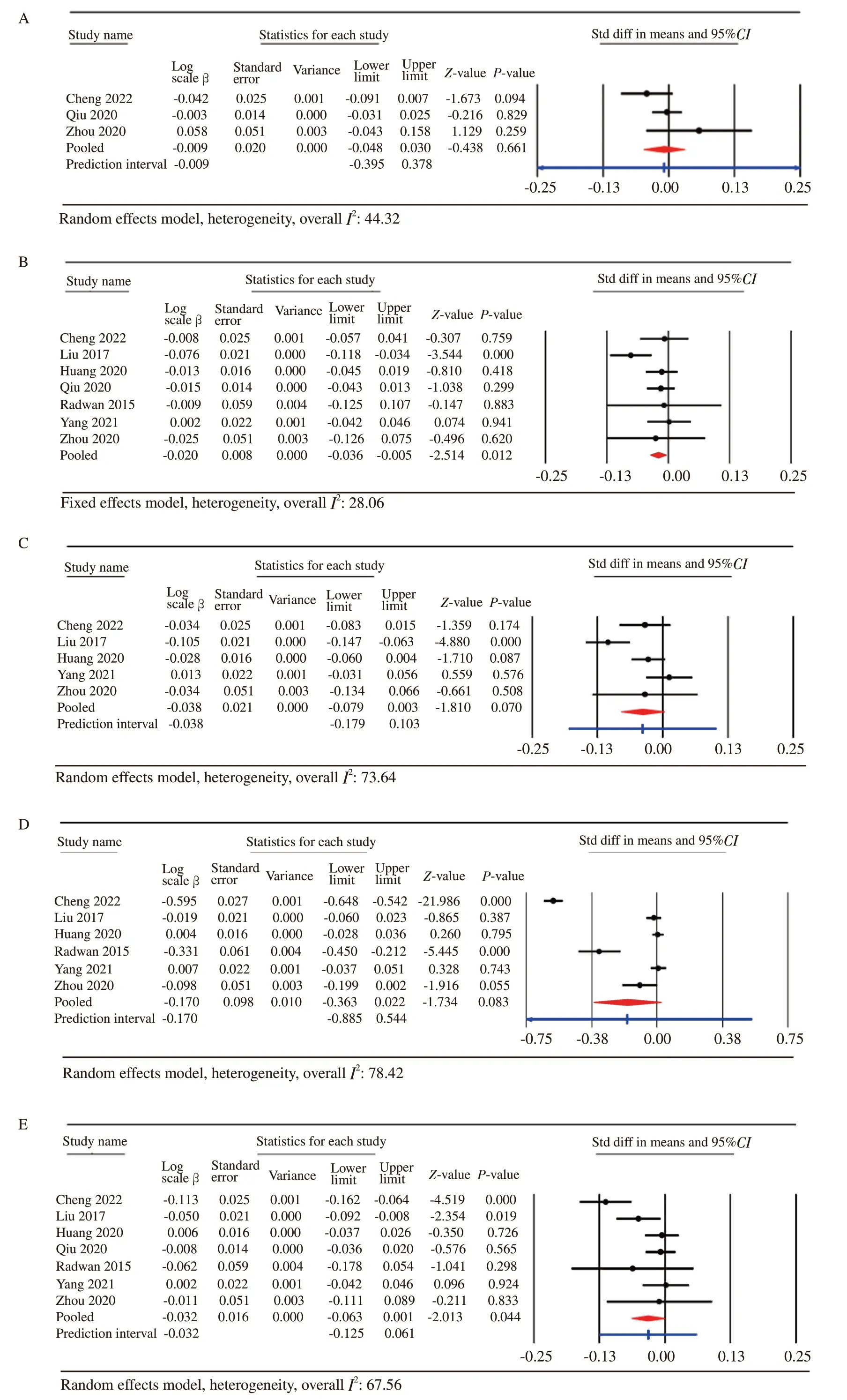
Figure 2.Forest plots show the relationship between SO2 exposure and the following semen parameters: semen volume (A),sperm concentration (B),total sperm count (C),total motility (D),and progressive motility (E).
3.3.2.Subgroup analysis
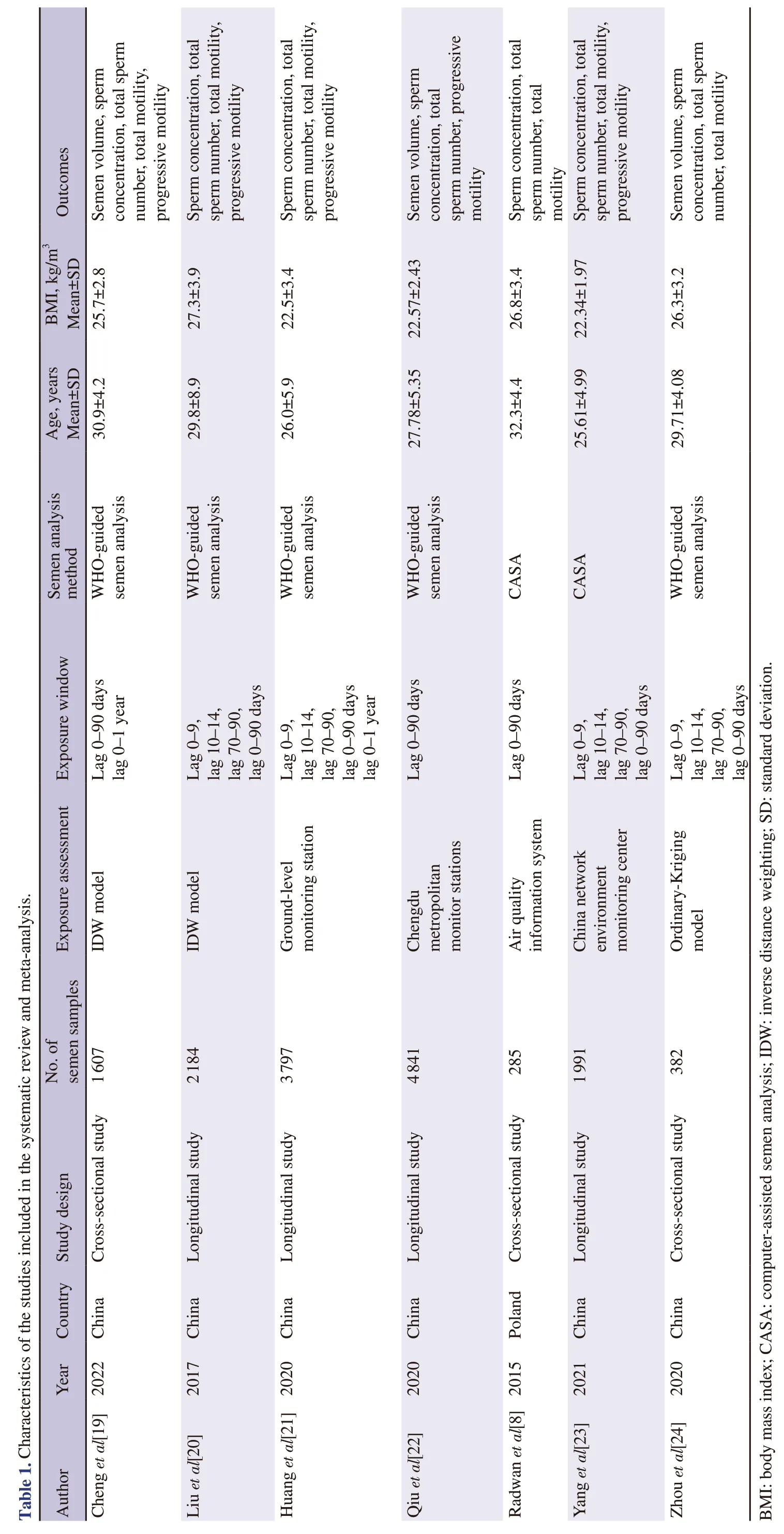
Subgroup analyses were conducted to explore potential sources of heterogeneity and assess the impact of specific factors on the association between ambient SO2and progressive motility (Table 3).These analyses considered factors such as study design (crosssectional or longitudinal),semen analysis method [computer-assisted sperm analysis (CASA) or World Health Organization (WHO)-guided semen analysis],and BMI categories (<25 and ≥25 kg/m2).The results demonstrated consistent associations between ambient SO2and semen quality outcomes across different subgroups,indicating the robustness of the observed relationship.The overall pooled effect in the subgroup analysis remained consistent across various potential sources of heterogeneity.The cross-sectional group exhibited lower semen quality in men (PC=-0.076;95%CI: -0.142 to -0.009;P=0.027),indicating a significant correlation between the study design and semen quality parameters following exposure to SO2.Furthermore,a significant relationship was found between BMI≥25 kg/m2studies and lower semen quality parameters following exposure to SO2(PC=-0.068;95%CI: -0.114 to -0.023;P>0.05).

Table 3. Subgroup meta-analysis of the included studies.
3.3.4.Sensitivity analysis and publication bias
Publication bias was assessed using Egger's test and visual inspection of the funnel plot.These tests revealed no significant evidence of publication bias [(semen volume coefficient: 0.674;standard error (SE): 2.450;95%CI: -30.45 to 29.80,P=0.828),(sperm concentration coefficient: -0.137;SE: 1.246;95%CI: -3.34 to 3.06,P=0.916),(total sperm count coefficient: -0.079;SE: 3.308;95%CI: -10.60 to 10.40,P=0.982),(total motility coefficient:-9.146;SE: 1.941;95%CI: -36.74 to 18.45,P=0.409),progressive motility coefficient: -1.542;SE: 1.776;95%CI: -6.10 to 3.02,P=0.424)].These data are supported by the symmetrical distribution of data points in the funnel plot (Figure 3).A sensitivity analysis was performed to assess the robustness of the meta-analysis results.Removing each study from the analysis did not significantly change the overall conclusions,indicating the stability of the findings (Figure 4).

Figure 3.Funnel plot to assess the presences of publication bias about SO2 exposure and semen parameters,including A) semen volume,B) sperm concentration,C) total sperm count,D) total motility,and E) progressive motility.
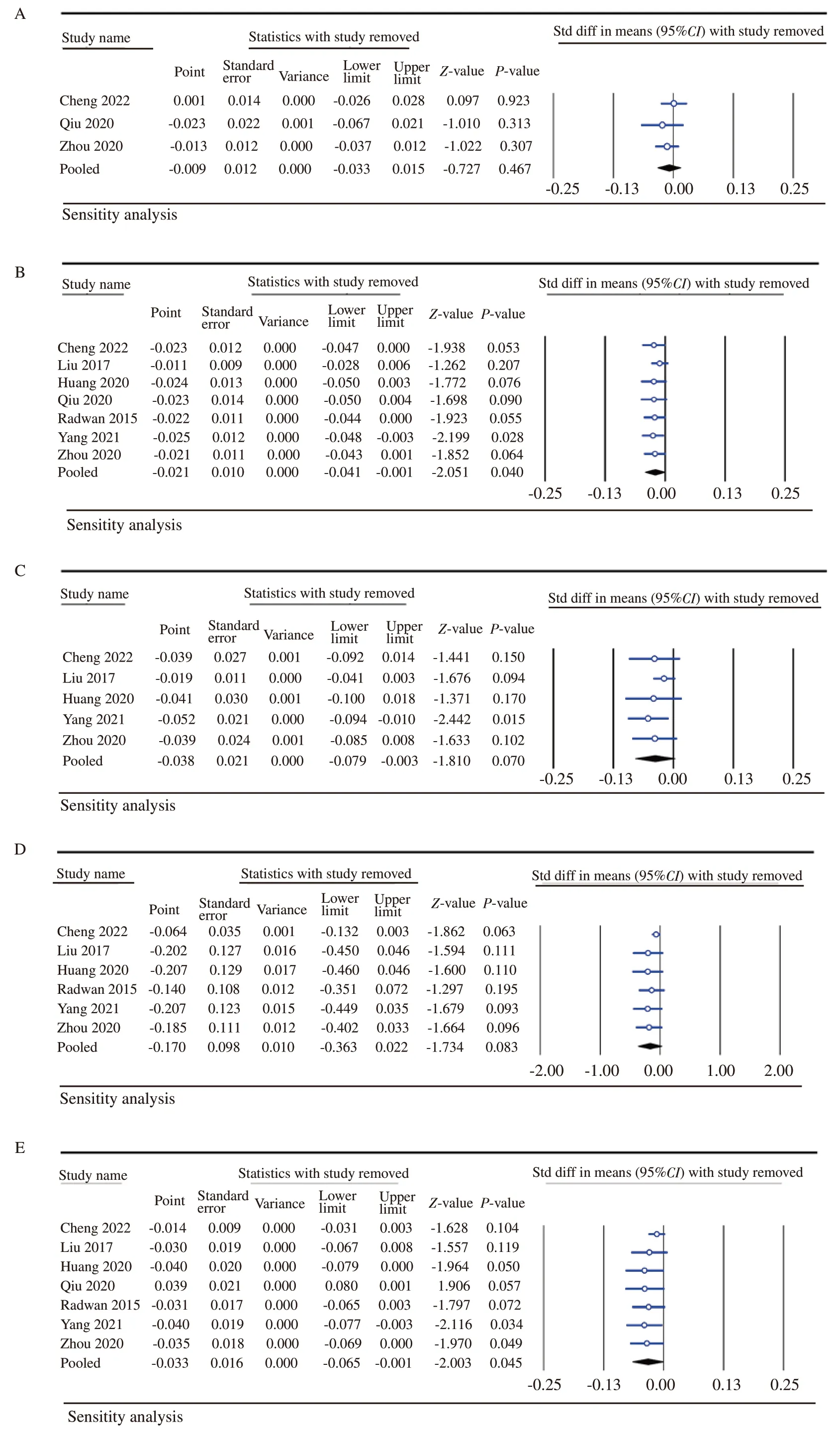
Figure 4.Sensitivity analysis plot of SO2 exposure and semen parameters,including A) semen volume,B) sperm concentration,C) total sperm count,D) total motility,and E) progressive motility.
4.Discussion
Our systematic review and meta-analysis focused on examining the association between SO2exposure and semen quality parameters and highlighted the potential impact of air pollution on male reproductive health.The findings of this study provide critical insights into the effects of SO2on semen quality and underscore the importance of understanding the impact of air pollution on human fertility.The results of the current meta-analysis indicate a clear link between exposure to environmental SO2and adverse effects on semen quality parameters,specifically total sperm count,total motility,and progressive motility.The findings demonstrate that higher levels of SO2in the environment are associated with a decrease in total sperm count,total motility,and progressive motility.Moreover,significant declines were observed in both sperm concentration and progressive sperm motility parameters.These results are consistent with previous studies investigating the relationship between air pollution and sperm quality and support the idea of the harmful effects of air pollution on male reproductive health[22,23].
Subgroup analyses were performed to investigate potential sources of heterogeneity and determine the impact of specific factors on the relationship between ambient SO2and progressive mobility.These analyses considered various factors,such as study design (crosssectional or longitudinal),method of semen analysis (CASA or WHO-guided analysis),and BMI categories (less than 25 kg/m2and greater than or equal to 25 kg/m2)[25,26].The findings indicated that studies with higher BMI and longer follow-up periods in longitudinal studies exhibited larger effect size values.Furthermore,studies that adhered to WHO guidelines experienced more pronounced changes in sperm motility.
The association between environmental SO2pollution and decreased sperm quality raises essential questions about the biological mechanisms involved.One explanation in this case is the ability of SO2and other air pollutants to cause oxidative stress in sperm.Oxidative stress is caused by the excessive production of reactive oxygen species (ROS) and their overcoming the body's antioxidant defense system[27].There are several evidences that increased oxidative stress significantly affects sperm motility,concentration,and morphology through mechanisms such as plasma membrane damage,DNA damage,and sperm apoptosis.Therefore,oxidative stress and its associated parameters are among the most critical predictors of sperm health[28,29].The findings of an additional study indicate that SO2exposure induces an elevation in H2O2levels[4].This rise in H2O2concentration subsequently reduces NADPH levels,constraining the antioxidant defense mechanism and promoting membrane peroxidation.Moreover,it results in an elevation of ROS,which ultimately impacts sperm quality[28,30].A simulated study also discovered that exposure to SO2particles can trigger oxidative stress by activating endoplasmic reticulum stress,decreasing sperm quality[31].Another factor that may affect sperm quality is inflammatory injury.Inflammatory injury affects the male reproductive system and can disrupt its function,leading to changes in sperm function[32].Exposure to air pollution,particularly SO2,can lead to inflammation through the release of proinflammatory cytokines and particles[33].Inflammatory mediators have the potential to affect the function of the blood barrier in the testicles.They can interrupt hormone production,disrupt the microenvironment that is necessary for sperm growth,and lower the quality of sperm[34].Exposure to air pollutants containing endocrinedisrupting chemicals (EDCs) may adversely affect sperm quality by disrupting the endocrine system.Endocrine-disrupting chemicals disrupt every aspect of hormone function responsible for maintaining homeostasis and regulating growth processes.It is widely understood that these compounds can have detrimental effects on production by impeding the hormone-dependent metabolic pathways responsible for the growth of gonads.This interference can occur through direct interaction with hormone receptors,disrupting their balance,or through epigenetic methods and regulation of cell cycles[35].Several studies have demonstrated significant decreases in fertility biomarkers,particularly sperm count,and poor sperm performance in human populations exposed to these compounds[36-39].
The systematic review and meta-analysis performed possess several strengths that enhance the validity and reliability of the findings.Through amalgamating outcomes from numerous studies,an overall effect size estimation was achieved,elevating the statistical robustness of the analysis.Moreover,the focus centered explicitly on the impacts of airborne SO2,facilitating a more profound comprehension of this specific air pollutant's effects on semen quality.In addition,our comprehensive assessment of several semen quality parameters,including sperm concentration,total sperm count,motility,and morphology,provides an overview of the effects of SO2on various aspects of semen quality.
Despite these strengths,our study has limitations that should be considered.First,the included studies were mostly observational,which limits our ability to establish a causal relationship between environmental SO2exposure and sperm quality.Further,prospective cohort or experimental studies must confirm the observed associations and clarify the underlying mechanisms.Second,the heterogeneity of the included studies,resulting from differences in study design,population characteristics,exposure assessment methods,and semen quality analysis,may have led to different results.Although we performed meta-regression and subgroup analyses to examine potential sources of heterogeneity,residual heterogeneity may still exist.Another limitation is that most of the studies included relied on city-level air pollution data or indirect exposure assessment methods,which may lead to exposure misclassification.Future research should aim to incorporate individual-level exposure data at higher spatial resolution to improve the accuracy of exposure assessment.In addition,most of the included studies were conducted in specific regions,which may limit the generalizability of our findings to other populations and geographic regions.Future studies must include more diverse populations from different regions to improve the external validity of the results.
In conclusion,this systematic review and meta-analysis provide compelling evidence for the negative correlation between ambient SO2exposure and semen quality.The findings highlight the importance of recognizing air pollution,particularly SO2,as a potential risk factor for male reproductive health.In addition,they highlight the need for further research to validate these associations and investigate preventive measures to reduce the adverse effects of SO2pollution on semen quality.
Conflict of interest statement
The authors declare no conflicts of interest to disclose.
Acknowledgments
The authors would like to express their gratitude to the researchers whose articles were utilized in this study.
Funding
The study received no extramural funding.
Authors’ contributions
Seyed Sobhan Bahreiny and Dr.Moslem Javidan designed the study,collected all the data,and drafted the manuscript.Mojtaba Aghaei and Dr.Hamid Ghorbani also contributed to the search strategy,article search,study selection,and manuscript preparation.Dr.Reza Mohammadpour Fard and Seyed Sobhan Bahreiny analyzed and interpreted the scientific data and results.Finally,all authors have read and approved the final manuscript.
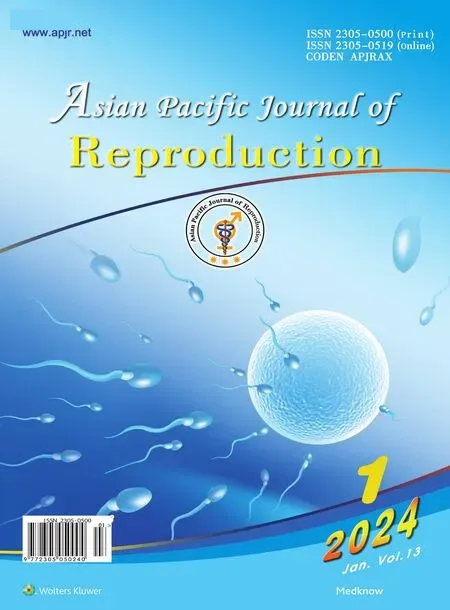 Asian Pacific Journal of Reproduction2024年1期
Asian Pacific Journal of Reproduction2024年1期
- Asian Pacific Journal of Reproduction的其它文章
- Promotion of sexual and reproductive health in Pakistan-The role of technology and online awareness
- Adding chitosan nanoparticles of green tea extract in diluent and thawing temperatures ameliorate the post-thawed quality of Boer buck semen
- Pro-fertility effect of Ficus carica fruit extract in streptozotocin-induced male rats
- Subsequent pregnancy outcomes and fertility rates in the case series that underwent bilateral hypogastric artery ligation (BHGAL) due to severe postpartum hemorrhage
- The relationship between DNA fragmentation and the intensity of morphologically abnormal human spermatozoa
- Engineering of ovarian tissue for ovarian dysfunctions: A review
